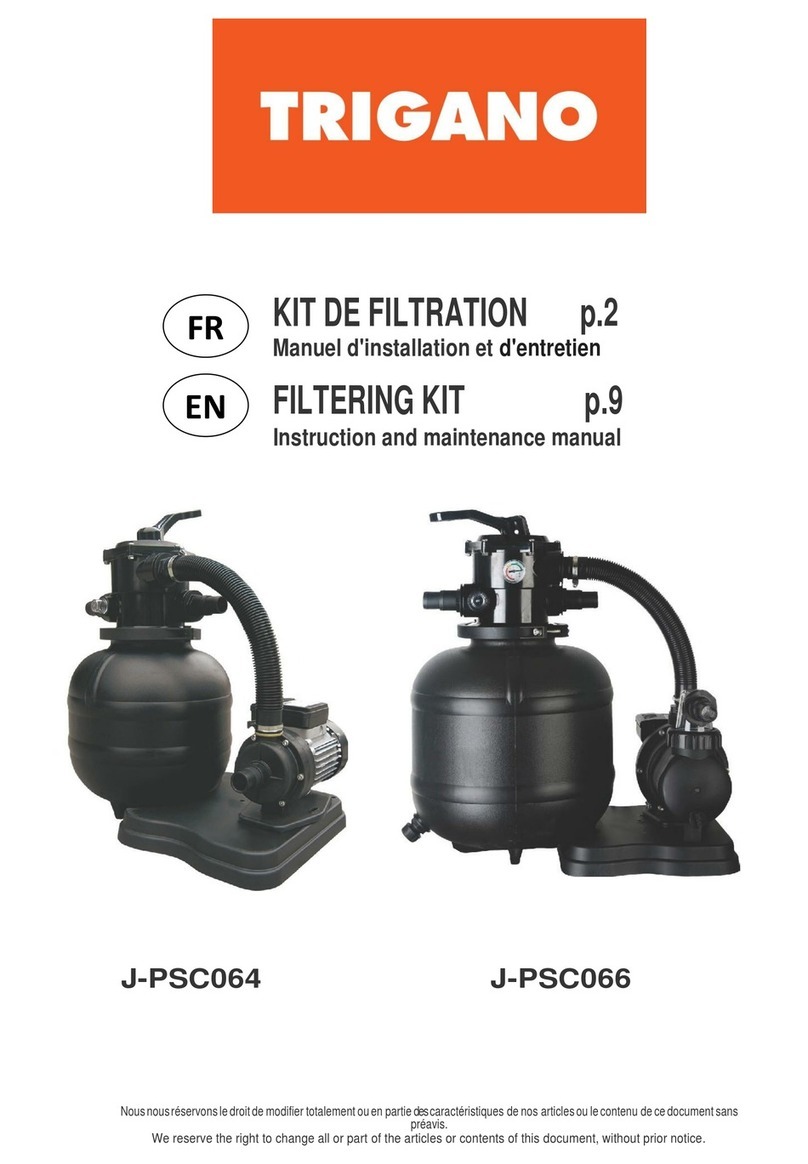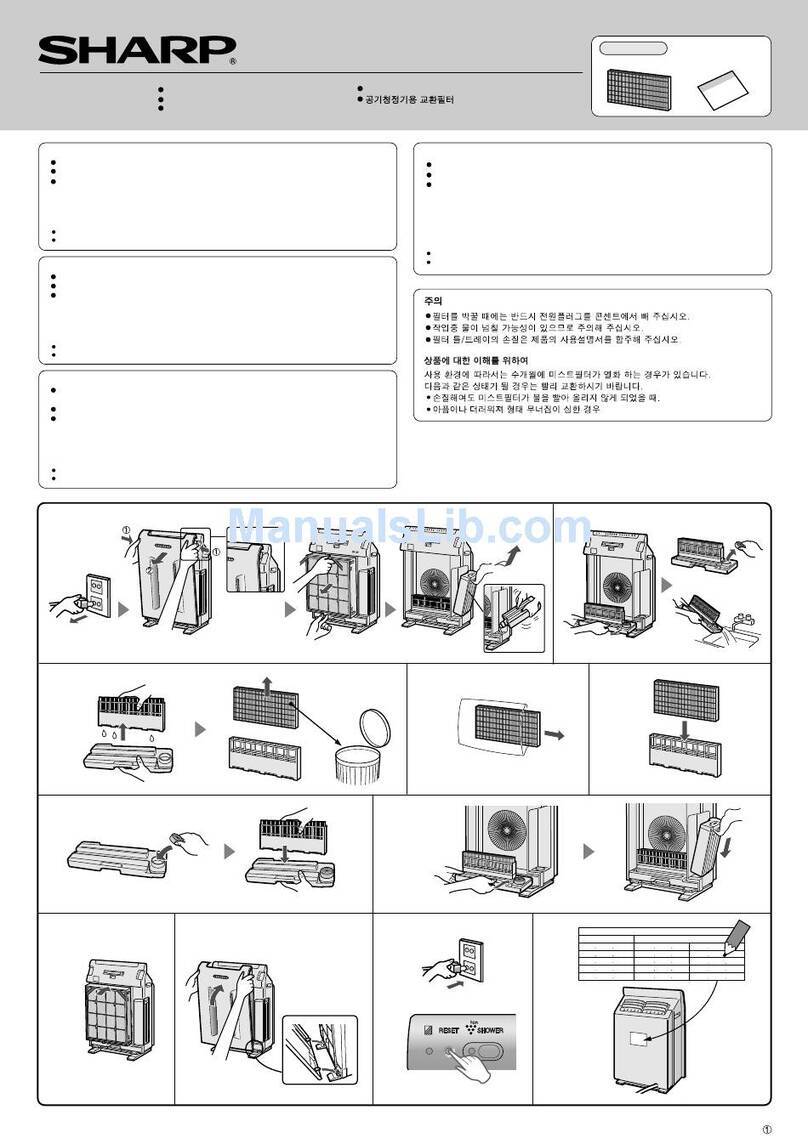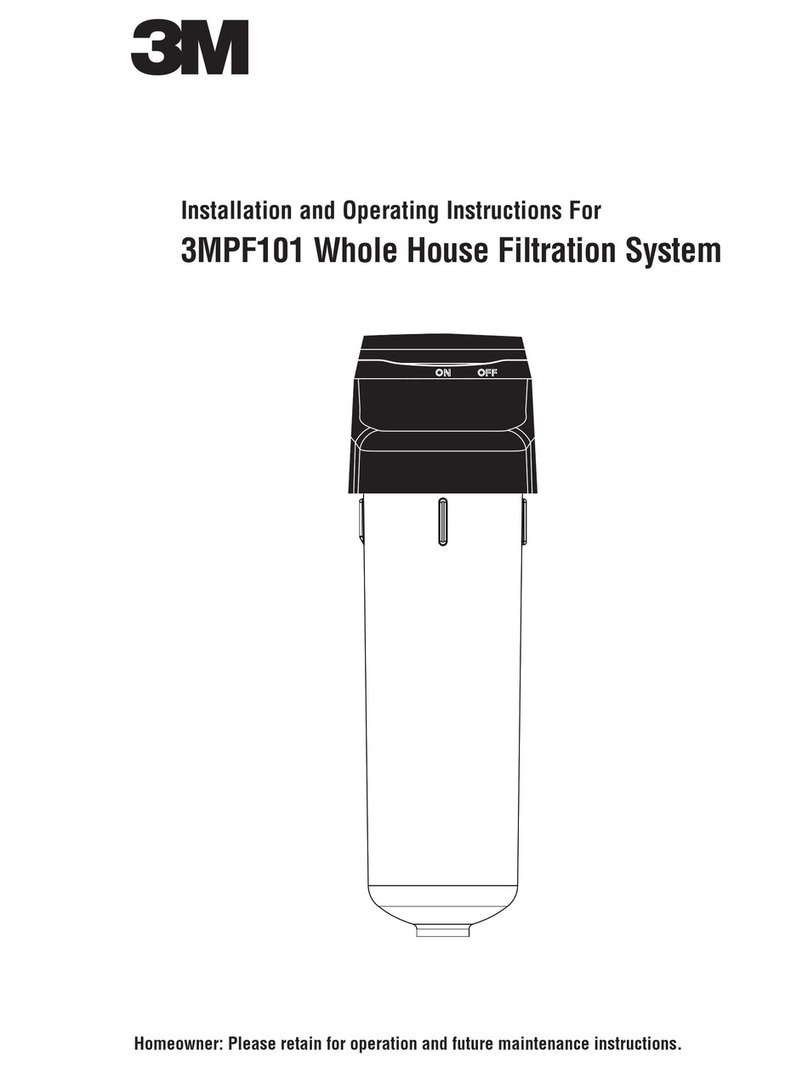Delta Environmental Products ECOPOD-N Series Guide

K4509 11/09
P.O. BOX 969, DENHAM SPRINGS, LA 70727
(225) 665-6162 – Telephone
(225) 664-9467 – Fax
ECOPOD-N™Series
Fixed Film Wastewater Treatment System
Safety Instructions
Installation and Service Manual

2
INTRODUCTION
A WORD ABOUT YOUR DELTA
ADVANCED WASTEWATER TREATMENT
SYSTEM AND HOW IT WORKS
The ECOPOD-N™Fixed Film Wastewater Treatment System
that you have purchased produces high quality water suitable
for various disposal methods. It is used to enhance your on-site
wastewater disposal system. You can be proud that in purchasing
your ECOPOD-N™Fixed Film Wastewater Treatment System
and with a minimum amount of maintenance, you can directly
contribute to a cleaner, safer environment.
All wastewater treatment systems of this type work by using
the bacteria that nature has provided. By pumping air into the
system, the bacteria grow and thrive in much larger amounts than
would occur naturally. The over population of bacteria speeds
up the process of breaking down domestic wastewater, making it
safe for release into the environment. This entire process takes
place within the walls of your specially designed, self-contained
ECOPOD-N™Fixed Film Wastewater Treatment System.
The result of this process is a clear, odorless discharge, which
meets or exceeds state water quality standards.
By following the few simple steps that you find in this manual, your
ECOPOD-N™Fixed Film Wastewater Treatment System will provide
you with years of service and the knowledge that you are doing
your part to protect public health, our ground water, lakes, rivers,
and streams.
The ECOPOD-N™Fixed Film Wastewater Treatment System
may be only one of several components required by your health
department to provide a complete on-site system.
ECOPOD-N™DESCRIPTION
Wastewater enters a pretreatment/settling tank similar to
conventional septic tanks. In this tank, debris and settleable
solids settle to the bottom and are decomposed by anaerobic
bacteria.
The effluent leaves the pretreatment tank and enters the
ECOPOD-N™Fixed Film Wastewater Treatment System reactor
tank, where it is introduced to an oxygen-rich environment. In
this oxygen rich environment, a colony of bacteria, called the
biomass, develops and is capable of digesting (breaking down)
biodegradable waste into carbon dioxide and water. This is a
continuous process as long as the biomass is supplied with
incoming wastewater and oxygen. The ECOPOD -N®Fixed Film
Wastewater Treatment System is a specially designed containment
device that houses an engineered plastic media specifically
designed to treat domestic wastewater. The engineered plastic
media has a 19mm sheet spacing with a total surface area of 47
square feet/cubic feet of media pack. The ECOPOD -N®Fixed
Film Wastewater Treatment System is submerged in a tank of
liquid, which operates as a dilution/recirculation clarifier zone.
An external air compressor is connected to the tank to provide
the necessary air to the system. There are no moving mechanical
parts or filters in the ECOPOD -N®Fixed Film Wastewater
Treatment System.
In this system, conditions are favorable only to attached growth
bacteria. This means that the most common disadvantages of
other types of systems are eliminated. No rising sludge, floating
sludge or washouts can occur.
In addition to CBOD and TSS reduction, ammonia nitrogen is
one of the contaminants reduced by the ECOPOD-N™ Fixed
Film Wastewater Treatment System Nitrification of the ammonia
and denitrification of nitrates occur within the bacteria masses.
Complete nitrification occurs in the reactor zone, as the liquid is
recirculated in the tank, the nitrates flow through the anoxic zone
where they come into contact with the carbon source present in
the sludge at the bottom of the tank. The nitrate is stripped of
the oxygen molecule converting the nitrate to nitrogen gas. A
50%+ removal rate of total nitrogen is common without any type
of recirculation or cycling of the blower.
Fecal Coliforms are yet another constituent of domestic
wastewater that, when reduced, are indicative of the overall
pathogen reduction performance of the treatment system. The
ECOPOD-N™Fixed Film Wastewater Treatment System is capable
of reducing fecal coliforms to under 30,000 counts per 100ml.
By following the few simple steps that you find in this manual, your
ECOPOD-N™Fixed Film Wastewater Treatment System will provide
you with years of service and the knowledge that you are doing
your part to protect public health, our ground water, lakes, rivers,
and streams.

3
Homeowner Care And Operation Instructions
The ECOPOD-N™Fixed Film Wastewater Treatment System has
been designed and built to provide long term, reliable and efficient
service.
Once the unit has been installed, (see installation instructions) the
unit will operate with a minimum amount of attention.
Please reference the system’s Data Plates that are located on the
tank, air pump and the alarm panel in the event that a problem
arises or service is required.
The following should be accomplished as checks for system
failure:
Daily: Observe the warning device, which comes
on when the power to the air pump has been
interrupted or when the air supply system has
malfunctioned or when there is a high water
level in the treatment plant. If the alarm is
activated check for a blown fuse or thrown
circuit breaker. Check air pump to be sure
it is operating. Once accustomed to the
soft humming sound of a properly operating
unit, any unusual noise is an indication of
malfunction. If an unusual noise is detected or
total failure is observed, call your local dealer
for service.
Weekly: Check the treatment plant for offensive odor.
If such a condition should develop, call an
authorized Delta dealer/distributor.
Every 3 Months: The air filter on the air pump should be
cleaned. Rinse with warm water if necessary.
(See installation instructions). Do not use oil or
other solvents.
Every 6 Months: Inspect and make any necessary adjustments
to mechanical and electrical components.
Inspect effluent quality’s color, turbidity and
check for any odor.
Take a sample from the reactor tank to check
the sludge level described in the “Solids
Removal” section.
The homeowner must be notified in writing
if any improper operation is observed and
cannot be corrected at the time of service.
Note: To keep maintenance to a minimum and
ensure high effluent quality, the following items
should not be permitted to enter the system.
Items Not Permitted In System
• Strongdisinfectantsorbleaches,otherthansmallamounts
normally utilized in day to day cleaning and laundry (be
conservative). Laundry detergents recommended for use
are low-sudsing, low phosphates and biodegradable, such as
Gain, Arm & Hammer, All, Fresh Start and Dash Bright.
• Dischargefromwatersoftener.
• Anytypeofoils,greases,orotherchemicalwastes.
• Disposablebabydiapersandwipes.
• Sanitarynapkins,condomsorothersimilaritems.
• Hair,bandages,ragsorstring.
• Latex,plasticormetallicobjects.
• Coffeegroundsorcigarettebutts.
• Mudorsticks.
• Papertowels,napkinsorKleenex
• TidyBowltypeproducts.
• Beerwasteoranyotherrichliquids.
• Garbagedisposalshouldbeusedsparingly,notasamethod
of disposing all solid food waste. In order to ensure good
plant operation, waste should be disposed of in the garbage
container.
The ECOPOD-N™Fixed Film Wastewater Treatment System
is designed to handle domestic wastewater and nothing else
should go into it. For anything other than domestic wastewater
contact Delta Environmental Products.

4
Warnings
1. The proper operation of this or any other home sewage
system depends upon proper organic loading and the life
of the microorganisms inside the system. Delta is not
responsible for the in-field operation of a system, other
than the mechanical and structural workings of the plant
itself. We cannot control the amount of harsh chemicals
or other harmful substances that may be discharged into
the system by the occupants of a household, we can only
provide a comprehensive owner’s manual that outlines
substances that should be kept out of the system.
2. Hydraulic overloading (flows in excess of design flow) may
cause the sewage treatment system not to perform to the
fullest capabilities.
3. Ants have been shown to be destructive to the air pump.
Regular care should be taken to prevent infestation of ants
near the system. Damage or destruction by ants is not
covered under manufacturer’s warranty.
4. Your State or Local Health Department may require
other pieces of equipment to function separately or in
conjunction with equipment manufactured by Delta
Environmental Products. Delta Environmental Products
is not responsible for the mechanical or electrical safety
of equipment it does not manufacture or supply with its
ECOPOD-N™Fixed Film Wastewater Treatment System.
Particular care should be used in evaluating the electrical
or mechanical safety of equipment manufactured by others.
This may include but not be limited to electrical control
panels or air pumps.
5. If electrical service has not been installed for checking air
distribution system during installation, and if an extension
cord is used to test the air pump, never leave the extension
cord plugged in. Remove it after testing is completed.
6. Due to a possible fire hazard, DO NOT plug into service
equipment or power pole and DO NOT use extension cords.
All electrical work performed by the installer or others must
be in accordance with the National Electrical Code and
Local Codes.
Solids Removal
The ECOPOD-N™Fixed Film Wastewater Treatment System is
designed to provide years of trouble free operation.
Determination of the need for solids removal can be done through
a simple test. A one quart sample should be pulled from the
reactor tank and can be done so through the 4” sample port.
Allow the sample to settle in a clear one quart jar for one hour.
If the solids content exceeds 25 percent of the total volume
after settling or more than 13 inches of sludge the treatment
unit should be pumped out. Call your local authorized sewage
disposal service to have the tank contents pumped out and
disposed of properly.
The method of pumping out should be as follows:
• Theairpumpshouldintheoffposition.
• Removeallofthesolidsfromboththereactortankand
primary tank.
After the pump-out process is complete, fill the tank with fresh
water to normal operating level.
Refer to the Installation Instructions to get the treatment plant
back into operation.
Should indication of improper operation be observed at any point
in time, contact your local distributor.
NOTE: THE COST ASSOCIATED WITH PUMPING THE
TREATMENT SYSTEM IS NOT COVERED UNDER WARRANTY
AND IS NOT INCLUDED IN THE SERVICE POLICY.

5
Seasonal Use Guidelines Of ECOPOD-N™
Fixed Film Wastewater Treatment System
These guidelines are for conditions as outlined below and apply
for systems that are not in use for periods of time indicated. Site
conditions not covered by the following must be forwarded to
Delta for recommended guidelines to meet the particular site
conditions.
1. System is not in use for more than one month and less than
three months. Electrical power is left on and there are no
frost conditions.
• Leaveairpumponandsystemrunning.
2. System is not in use for more than three months. Electrical
power is turned off and there are not frost conditions.
• Removeallmaterialsandliquidfromtank.
• Rellwithcleanwater.
• Turnoffairpump.
3. System is not in use for more than three months. Electrical
power is on and there are no frost conditions.
• Leaveairpumponandsystemrunning;OR
• Removeallmaterialandliquidfromtank.
• Rellwithcleanwater.
• Turnoffairpump.
4. System is not in use. Electrical power is turned off and there
are frost conditions.
• Removeallmaterialandliquidfromtank.
• Turnoffairpump.
• Ifhighgroundwaterispresent,llwithcleanwater.
• Ifnogroundwaterispresent,leavetankempty.
UNDER NO CIRCUMSTANCES SHOULD THE AIR PUMP BE
TURNED OFF FOR MORE THAN A FEW DAYS WITHOUT
REMOVING TANK CONTENTS.
Sample Requirements
An ECOPOD-N™Fixed Film Wastewater Treatment System
properly operated and maintained should provide the following
effluent quality as determined through the analytical methods
described in NSF/ANSI 245:
Biological Oxygen Demand 5 day average (BOD5) of less than
30mg/1(orppm);
SuspendedSolids(SSoflessthan30mg/1(orppm);
Volatilesuspendedsolidsoflessthan30mg/1(orppm);
PHof6.0to9.0;
Total Nitrogen reduction of 50% (Minimum) of influent TN
Dissolved oxygen 1.5 to 3.0 mg/1 (or ppm).
Taking Effluent Samples
Samples must be taken in the effluent discharge line or an effluent
pump or after the disinfection device. We recommend allowing
the effluent to flow through the discharge pipe for a minimum of
two minutes before taking the sample. This will allow any solids to
be flushed out that might have accumulated in the discharge pipe.
Please find attached drawings of a Sample Port.
SAMPLING SHOULD BE TAKEN BY A LOCAL CERTIFIED
TESTING LABORATORY OR BY FOLLOWING THEIR
PROCEDURES. THE FOLLOWING RECOMMENDED
GUIDELINES MAY BE USED IF LOCAL PROCEDURES ARE
NOT AVAILABLE.
1. Biochemical Oxygen Demand (BOD)
Samples for BOD analysis may degrade significantly during
storage between collection and analysis, resulting in low BOD
values. Minimize reduction of BOD by analyzing the sample
promptly or by cooling it to near freezing temperature during
storage. However, even at low temperature, keep the holding
time to a minimum. Warm the chilled samples to 20° C be-
foreanalysis;somestoragetimecanbeusedtoaccomplish
this conveniently.
a. Grab Samples: If analysis is begun within two hours of
collection, cooling is unnecessary. If analysis is not started
within two hours of sample collection, keep sample at or
below 4° C from the time of collection. Begin analysis
withinsixhoursofcollection;whenthisisnotpossible
because the sampling site is distant from the laboratory,
store at or below 4° C and report length and temperature
of storage to the Lab. In no case, start analysis more than
24 hours after grab sample collection. When samples are
to be used for regulatory purposes, make every effort to
deliver samples for analysis within six hours of collection.
2. Total Suspended Solids (TSS)
Use resistant-glass or plastic bottles, provided that the mate-
rial is suspension does not adhere to container walls. Begin
analysis as soon as possible, because of the impracticality of
preserving the sample. Refrigerate sample at 4° C to mini-
mize microbiological decomposition of solids.
3. Phosphorous
If phosphorus forms are to be differentiated, filter samples
immediately after collection. Preserve by freezing at or below
-10° C. Add 40 mg/HgCl2/L to the samples, especially when
they are to be stored for long periods. Do not add either
acid or 2CHCI3as a preservative when phosphorus forms are
to be determined. If total phosphorus alone is to be deter-
mined, add 1 ml concentration HCL or freeze without any
additions.
Do not store samples containing low concentrations of phos-
phorus in plastic bottles unless kept in a frozen state because
phosphates may be absorbed onto the walls of plastic bottles.
Rinse all glass containers with hot diluted HCL, then rinse
several times in distilled water. Never use commercial deter-
gents containing phosphate for cleaning glassware used in
phosphate analysis.
4. Ammonia Nitrogen
Most reliable results are obtained on fresh samples. Destroy
residual chlorine immediately after sample collection to pre-
vent its reaction with ammonia. If prompt analysis is impos-
sible, preserve samples with 0.8-ml concentration H2SO
4/L
samples and store at 4° C. The PH of the acid-preserved
samples should be between 1.5 and 2. Some wastewater
may require more concentration H2SO
4to achieve this pH. If
acid preservation is used, neutralize samples with NaOH or
KOHimmediatelybeforemakingthedetermination.

6
The ECOPOD–N®system has been carefully manufactured,
inspected and tested at the factory before shipment. Upon
receiving the unit, please follow this procedure.
1. Before unpacking, check the packaging for signs of damage.
If there is evidence of damage or abuse, notify Delta Environ-
mental Products at 1-800-219-9234
2. After unpacking, inspect the unit to ensure no components
are missing. Also inspect for damage to the unit. If any
discrepancies are found, notify Delta Environmental Products
at 1-800-219-9234
If the unit is free of damage, unpack completely and proceed with
the installation.
INSTALLATION INSTRUCTIONS ONLY FOR USE BY CERTIFIED, LICENSED INSTALLERS
Delivery Inspection
System Components-Reactor Tank
Air Pump Installation

7
INSTALLATION
1. Prepare an excavation, having a diameter approximately
one foot larger than the tank and a depth that will allow
approximately three inches of the inspection port to extend
above normal ground level. Backfill with a six inch layer of
sand or gravel if otherwise unable to provide a smooth, level,
compact base. We recommend that the hole be roped off in
some fashion to prevent injury to passersby.
2. Utilizing lifting lugs provided, place the plant in the excavation
so that the inlet and outlet line up with the sewer piping.
The inlet line should slope down toward the plant and the
outlet line should slope down away from the plant. The plant
should be level within one-half inch, edge to edge.
3. Position inlet and outlet lines and make connections as
necessary, depending upon the construction materials. The
inlet line should be inserted and glued into the inlet elbow
and the discharge line should be inserted and glued into the
outlet coupling. Note: Open inspection port and make sure
discharge tee assembly is level and centered in clarifier prior
to attaching discharge piping. Fill the tank with water until
water flows from the discharge before back-filling. Backfill
around plant, up to the bottom of the discharge connections.
4. Do not install the air pump(s) in a low lying area where water
may accumulate. The air pump should be installed near the
control panel and within one hundred feet of the tank. Air
pump can be installed outdoors or in a clean, well ventilated
area, such as a tool room, garage, etc. If the linear air pump
is to be installed in an additional enclosure, the enclosure
must be approved by Delta in writing.
5. Mount the control panel in an area such that the alarm can
be heard and be readily observed. A 3-wire grounded GFI
circuit is required for safety. Install a disconnect switch near
the panel to visually disconnect the control panel from the
power source. All electrical work shall be done according to
NEC and local code requirements. The control panel must
be grounded. Connect the source ground wire to the ground
location in the panel.
6. The control panel is rated for indoor and outdoor use and
contains a fuse or circuit breaker for the air pump. An
electrical malfunction in the air pump or wiring to the air
pump will cause the fuse to blow or circuit breaker to trip.
The control panel also contains a pressure switch and visual
and audible alarm. Loss of air pressure caused by the
air pump system malfunction or a high water level in the
treatment plant will cause the alarm to sound and light to
illuminate.
7. Attach control panel to suitable mounting surface using all
four mounting holes on back of box. Use proper screws of
sufficient length to insure a secure and permanent mounting.
8. Controlpanelisratedforoutdoorservice;however,donot
place it where it can be immersed in rising water or where
run-off water such as from a roof will fall on it. Do not mount
it where it is subject to wetting from sprinklers, hoses, etc.
9. The control panel must never be connected to a circuit
that is not properly grounded. Never connect the unit to
a non-grounded circuit. If there is doubt, have a qualified
electrician check for proper grounding. The control panel
must be connected to a 20 amp maximum electric source
equipped with a ground fault interrupter (GFI) circuit breaker.
A standard circuit breaker can be replaced with a GFI circuit
breaker which can be obtained from almost any store that
sells electrical supplies.
10. After the control panel is properly mounted, connect conduit
and install wiring as shown on drawings bound herein.
11. Install float switch wire from the control panel to the
treatment plant. Wire can be direct burial type UF 600
volt or can be installed in schedule 40 PVC conduit. Use
type THWN, 600 volt if installed in conduit. Wire must be
buried in accordance with NEC table 300-5. If in doubt,
bury24inchesdeep.Keepsufcientdistanceordepth
from air line to avoid confusion of pipes or damage to wiring
during installation or repair of air piping. Connect to the float
switch normally open contacts using underground rated
compound filled wire nuts. Float switch is not required when
a dual pressure switch is utilized which detects high water
conditions.
12. Connect the pressure air tubing to the 1/8” barb-fitting in
the air piping system. The air tubing should be protected by
conduit as shown on drawing.
13. Install 3/4” schedule 40-PVC piping between air pump and
treatment unit. A minimum of 12 inches ground cover is
recommended.
14. Turn power on to control panel. Air pump should start.
15. Check air piping joints for leakage using a soapy water
solution. Repair if necessary and then carefully backfill air
line and inlet and discharge piping and cover plant to grade
level.
16. Re-check water level in the tank.
17. Plant is ready to receive incoming sewage. No special
start-up procedures are required. The process is naturally
occurring and does not require any special additives
18. Test alarm circuit by momentarily squeezing air tubing and
allowing air pressure to decrease. This should take a few
minutes. Alarm should occur. Release air tubing and alarm
should stop. Lift float in tank (if included) to horizontal
position. Alarm should occur. Release float. Alarm should
stop. The audible alarm can be turned off by flipping the
toggle switch on the panel front door to the left.
19. Close cover to control panel, and lock if necessary.
20. In the event that a fuse blows, replace with time delay or slow
blow, 125 volt minimum voltage rating and the same amp
rating as the existing fuse.
21. The distribution of air to all drop lines must be uniform. If the
air flow is not evenly distributed, check the air pump or the
main air line.
22. Spend time with your customer whenever possible. Review
operation instructions. Be sure that the customer has a
manual to keep. This saves valuable time avoiding return
visits.
23. Retain these instructions for future reference.
24. n WARNING: CONTROL PANEL CONTAINS HIGH VOLTAGE
AND MUST ONLY BE INSTALLED AND SERVICED BY QUALIFIED
PERSONNEL.

8
TROUBLESHOOTING GUIDE FOR DELTA
ECOPOD-N™FIXED FILM WASTEWATER
TREATMENT SYSTEM
Procedure for Visual and Olfactory
Evaluation of System
1. Check to be sure that the air system is working properly. This
will be evident in the reactor as the liquid will be forcefully
agitated. A septic (rotten egg) odor could mean that the sys-
tem is not getting enough air. If the air system is not working,
partially working or working very little (slight bubbles), check
the following:
a. Check to be sure the air pump is working.
• Checktimerifoneisused;
• Bypasstimerandtemporarilyconnectdirectlytosource;
• Checktheelectricalsource;
• Ifelectricalsourceisokay,checkserviceguideonpump
unitfortroubleshootinginformation;
• Washairlteronpump;
• Consultmanufacturerforservicinginformation.
b. Check to be sure tank is not severely out of level. Air
follows a path of least resistance. The pressure differences
can be enough to prevent or restrict air flow.
c. Check for broken or cracked air lines both outside and
inside the tank.
d. Ants will destroy an air pump. Check to see if there is an
ant nest around the air pump.
e. Air pump should be protected from rising water.
f. Always check to see if inlet and outlet lines are correctly
installed.
Internal Assembly Malfunction
1. Primary treated wastewater from the primary tank should not
enter directly into the dilution zone because of improperly
installed or loose seals or gaskets where pipe goes through
the tank wall. Check the size of holes to be sure that there is
no clearance for matter to pass through the wall around the
piping.
2. Check to be sure all internal piping and connections are tight.
Design Overload
1. The system could be hydraulically overloaded (there is too
much water going through the system for the size of the
system).
2. The system could be biologically overloaded (there is too
much waste for the size of the system).
Improper Installation Or Settling
1. You should follow the manufacturer installation procedures
very carefully.
2. Where settling is common, approximately 2 inches of sand
should be placed and tamped in the bottom of the hole.
3. Proper installation is the first step in preventing call backs for
service problems.
4. Whenever possible, it is important to spend time with the
homeowner. Be sure they have an operations book. A few
minutes invested in the beginning will avoid service calls later.
No Harsh Chemicals Should Be Put Into The System
1. Water in the reactor tank should be the relatively clear in both
the reactor and dilution zone. Blue or gray/blue water indi-
cates heavy use of detergents or other chemicals. If water
appears sudsy, there is too much detergent being used.
2. Water in the dilution zone should be clear. Water is dis-
charged into the discharge tee at a minimum of 6-8 inches
below water surface. You MAY not be able to see clear water
by looking into the tank. Samples must be taken at the
sample port.
3. Oils and grease should be kept to a minimum. Grease tends
to form in white balls.
Trouble Shooting Electrical System
1. Air pump does not run:
a.Checkmainserviceforpower;
b. Check and/or replace fuse with same rating as is in control
panel.
2. Alarm does not occur when air pump is off:
a. Malfunctioning pressure-switch – replace.
b. Malfunctioning light or buzzer – replace.
3. Alarm occurs continuously even when air pump is running:
a. Air-leak in main air system or air tubing to pressure switch
– repair leak or replace air line.
b. Malfunctioning pressure-switch – replace.
c. High water level in tank – inspect for cause.
d. Short in float switch wire or float switch – repair or replace.
NOTE: All replacement parts are available from your local dealer.
n CAUTION: Electrical shock or hazard may occur if unit is not
serviced properly. The manufacturer recommends that a licensed
electrician be called when electrical problems occur.

9
Component Replacement Procedure
1. Air Pump – Follow same procedure as outlined in the “Instal-
lation Instructions”.
2. Float Switch – Remove Treatment Plant’s Riser or 24 inch
cover. Locate float switch cable. Untie knot. Cut float switch
cable. Slip float switch cable through rubber grommet into
the plant. Replace with exact replacement float switch. Re-
install by reversing procedure. Reconnect float switch wires
using Underground Rated Compound filled wire nuts. See
Float Switch Mounting Detail.
3. Pressure Switch – Turn all power off to control panel. Re-
move screws securing pressure switch as well as connec-
tors and tubing. Reverse procedure to install new pressure
switch.
4. Buzzer – Turn all power off to control panel. Remove screw
attaching buzzer to back plate as well as connectors. Re-
verse procedure to install new buzzer.
5. Lamp-holder – Turn all power off to control panel. Remove
lock nut securing lamp-holder to door as well as connectors.
Remove lamp-holder. Install new lamp-holder with gaskets
furnished. Continue with reverse procedure.
6. Lamp – Turn all power off to control panel. Remove red
lamp cover from front of control panel. Remove and replace
lamp which is a push in type. Replace lamp cover and cover
gasket.
7. Fuse – Turn all power off to control panel. Pull top of fuse
holder outward. Remove and replace fuse. Push fuse back
into place.
8. Buzzer Switch – Turn all power off to control panel. Remove
rubber boot on switch. Remove hex nut from switch on panel
front as well as connectors on switch. Reverse procedure to
install new switch.
General Comments
1. Only factory approved equipment can be used for replace-
ment on individual treatment systems.
2. If the decision is made to pump out a system, be sure to
contact a licensed waste hauler.
3. If a chronic problem develops and all items listed have been
checked, consult with the factory.
4. Taking pictures of systems when troubleshooting will help
document activity in the field.
5. Keepgoodrecords.
NOTE: If the entire cover needs to be removed on any one of the
various model treatment plants, the existing silicone or strip seal
must be removed and replaced with a new one. This will provide
a positive seal which will not allow any infiltration into or out of
the treatment plant.
Treatment Plant
Treatment Capacity
(GPD)
Primary Tank Total
Volume (Gal)
Reactor Tank
Volume (Gal)
Reactor Tank
Dilution
Volume (Gal) Media Size Air Requirements
E50-N 500 500 710 580 2' x 2' x 4' 12 CFM
E60-N 600 600 916 736 3' x 2' x 4' 14.4 CFM
E75-N 750 750 1089 909 3' x 2' x 4' 18 CFM
E100-N 1000 1000 1427 1186 4' x 2' x 4' 24 CFM
E150-N 1500 1500 2130 1771 6' x 2' x 4' 36 CFM
Materials Of Construction
Suffix FF
Reactor Tank Fiberglass
Cover Fiberglass
Media Container Fiberglass
Suffix CA
Reactor Tank Concrete
Cover Concrete
Media Container Fiberglass
These are standard production units. Other configurations are available upon request.
ECOPOD-N™Fixed Film Wastewater Treatment System Unit Specifications

10
Model Compressor Motor full load Amps Measured Operating Watts Electrical Requirements
E50-N Delta Model E50 3.5 185 115 volt - single phase
E60-N Delta Model E60 4.7 280 115 volt - single phase
E75-N Delta Model E75 4.7 280 115 volt - single phase
E100-N Delta Model E100 7.1 475 115 volt - single phase
E150-N Delta Model E150 7.1 475 115 volt - single phase
TREATMENT
PLANT A B C D E F G H
E50-N 4'-113⁄16" 4'-2" 6'-0" 4' 5'-0" 10" 2' 3'
E60-N 5'-73⁄4" 4'-6" 6'-3" 4'-4" 5'-0" 111⁄2" 2' 3'
E75-N 6'-1⁄2" 4'-11" 6'-9" 4'-9" 5'-9" 111⁄2" 2' 3'
E100-N 6'-5-5⁄8" 5'-5" 7'-6" 5'-4" 6'-2" 1'-0" 2' 3'
E150-N 8'-3-5⁄8" 5'-9" 8' 5'-8" 6'-4" 1'-33⁄4" 2' 3'
REFER TO TREATMENT PLANT DRAWINGS ON THE ABOVE DIMENSIONS.
NOTE: For special cargo or container shipments 12 inches must be added to the diameters of all fiberglass units (due to the
fiberglass flange and lifting lugs).
Electrical Requirements
Dimensions

11
DELTA ENVIRONMENT PRODUCTS
INDIVIDUAL MECHANICAL WASTEWATER TREATMENT SYSTEM
SERVICE POLICY
INITIAL POLICY:
A two year initial service policy shall be furnished to the user by the manufacturer or the distributor through the dealer. This policy is
included in the original price and shall provide the following:
1. An inspection/service call every six months, which includes inspection, adjustment, and servicing of the mechanical and electrical
component parts as necessary to ensure proper function.
2. An effluent quality inspection every six months consisting of a visual check for color, turbidity, scum overflow, and an examination for
odors.
3. A sample shall be pulled from the aeration tank every six months as described in the “SOLIDS REMOVAL” section to determine if
there is an excess of solids in the treatment plant. If the test results determine a need for solids removal, the user will bear the cost
and responsibility for doing so.
4. If any improper operation is observed which cannot be corrected at that time, the user shall be notified immediately in writing of the
conditions and the estimated date of correction.
CONTINUING SERVICE POLICY:
An annually renewable service policy affording the same coverage as the Initial Service Policy is available. Consult your dealer for pricing
information.
PARTS:
Replacement parts or components may be obtained from your local distributor or directly from Delta Environmental Products.
COMPLAINTS:
In order for Delta Environmental Products to properly address complaints, we require that you put in writing the date and nature of the
complaint as detailed as possible. This must include the Serial Number of your system.
Send to: Delta Environmental Products
P. O. Box 969
Denham Springs, LA 70727-0969

K4509 11/09©2009 Delta Environmental Products
LIMITED WARRANTY
Pentair Water
1101 Myers Parkway
Ashland, Ohio 44805-1969
419-289-1144
Delta Environmental Products warrants the parts in each treatment system for a limited two (2)years.
All warranty questions shall be resolved through Delta Environmental Products. The warranty on
the treatment device is that the device is free from defects in material and workmanship from the date
of installation treating household wastewater. Some states do not allow limitations on how long an
implied warranty lasts, so the above limitation may not apply. Sole obligation under this warranty is as
follows: Delta Environmental Products shall fulfill this warranty by repairing or exchanging any com-
ponent part, F.O.B. factory that in Delta Environmental Products judgment shows evidence of
defects, provided said component part has been paid for and is returned through an authorized
dealer, transportation prepaid. The warrantee must also specify the nature of the defect to the
manufacturer.
The warranty does not cover treatment processes/devices that have been flooded, by external
means, or that have been disassembled by unauthorized persons, improperly installed, subjected to
external damage or damaged due to altered or improper wiring or overload protection.
This warranty applies only to the treatment process/device and does not include any of the house
wiring, plumbing, drainage, or disposal system. Delta Environmental Products is not responsible
for any delay or damages caused by
defective components or material, or for loss
incurred
because of interruption of service, or for any other special or consequential damage or expenses
arising from the manufacture, sale or use of this process/device.
Delta Environmental Products reserves the right to revise, change or modify the construction and
design of the treatment process/device for household wastewater or any component part or parts
thereof without incurring any obligation to make such changes or modifications in previously sold
equipment. Delta Environmental Products also reserves the right, in making replacements of compo-
nent parts under this warranty, to furnish a component part which, in its judgment is equivalent
to the part replaced.
Under no circumstances will Delta Environmental Products be responsible to the warrantee for any
other direct or consequential damages, including but not limited to lost profits, lost income, labor
charges, delays in production, and/or idle production, which damages are caused by a defect in
material and/or workmanship in its parts. Some states do not allow the exclusion of limitation of
incidental or consequential damages, so the above limitation or exclusion may not apply to you.
The warranty is expressly in lieu of any other express or implied warranty, excluding any warranty of
merchantability or fitness and of any other obligation on the part of Delta Environmental Products.
This warranty gives you specific legal rights, and you may also have other rights which vary from
state to state.
Table of contents
Popular Water Filtration System manuals by other brands

Thermo Scientific
Thermo Scientific Barnstead GenPure Quick reference guide
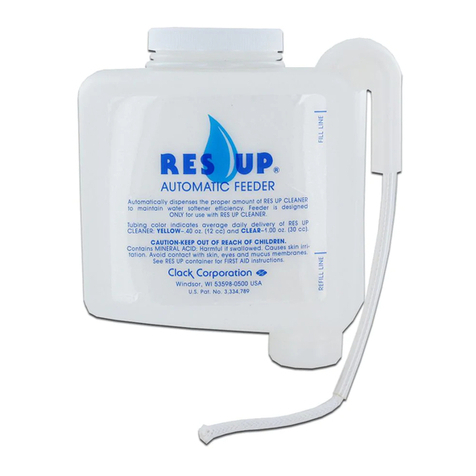
Clack
Clack Res-Up quick start guide

Oase
Oase Filtoclear operating instructions
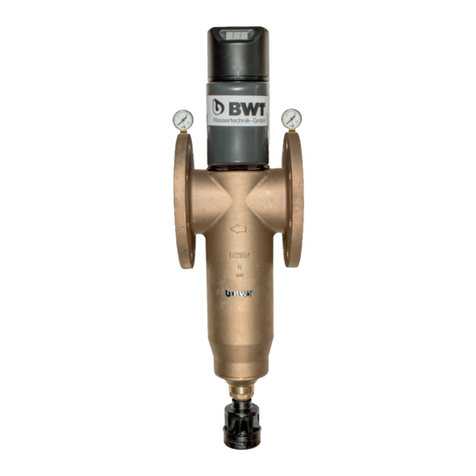
BWT
BWT Multipur AP Installation and operating manual
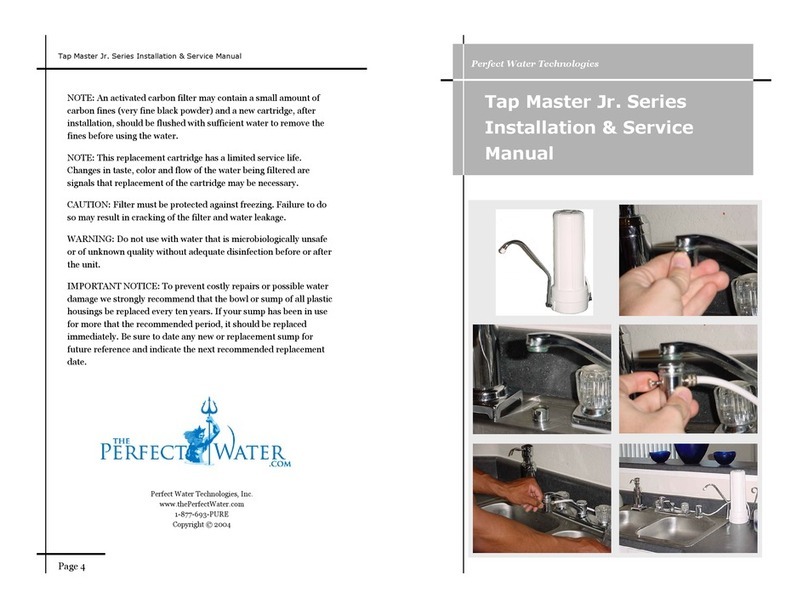
Perfect Water Technologies
Perfect Water Technologies Tap Master Jr Series Installation & service manual

Ecosoft
Ecosoft SENSE Installer and user guide
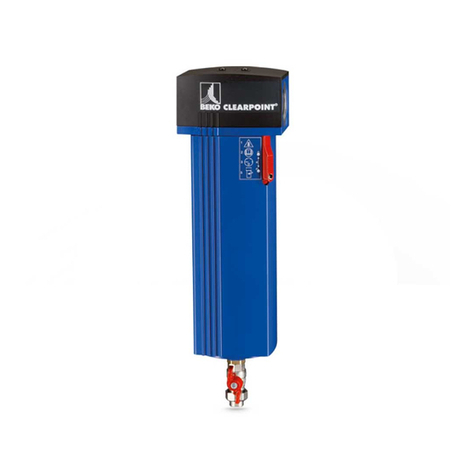
Beko
Beko CLEARPOINT S040 Installation & operation instructions
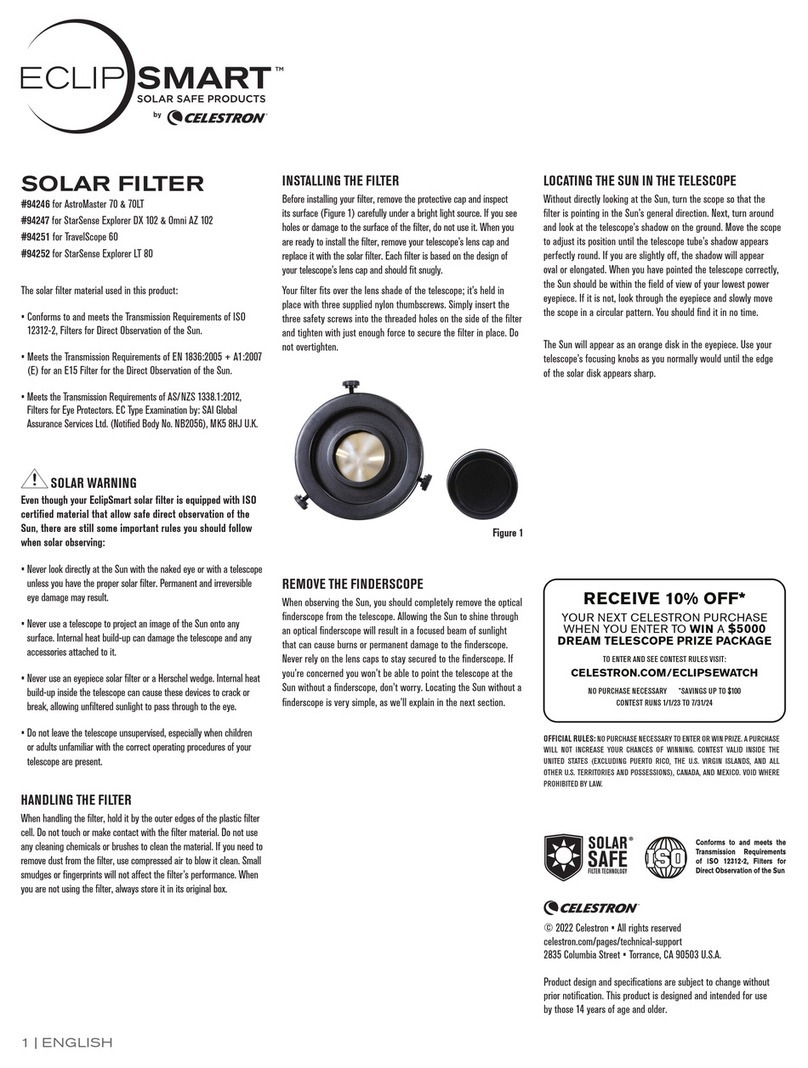
Celestron
Celestron ECLIP SMART 94246 manual

Watts
Watts Premier WP4V-50 Installation, operation and maintenance manual

Schaffner
Schaffner FN 3025 Installation guidelines
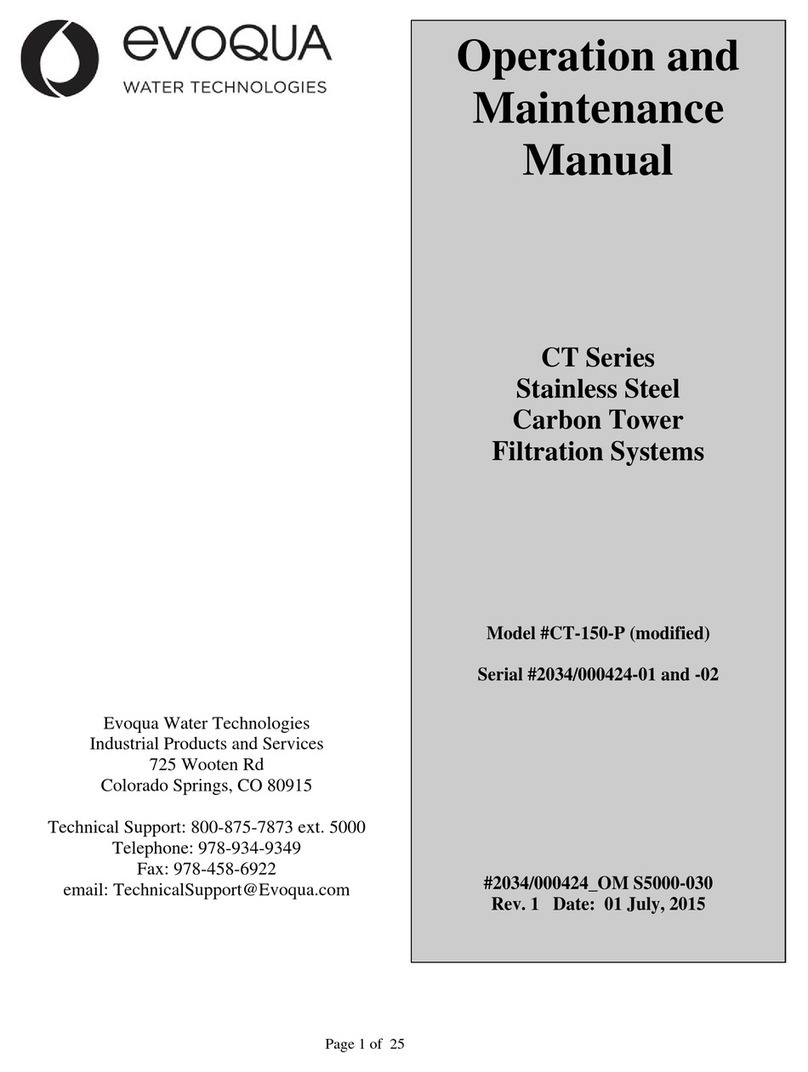
Evoqua
Evoqua CT Series Operation and maintenance manual

Graco
Graco 213-062 instructions
